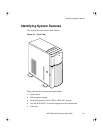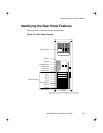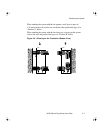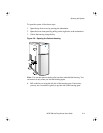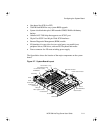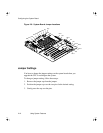
Configuring the System Board
2-10 Using System Features
Configuring the System Board
This section contains information to help you properly configure the system
board.
Features
The 64-bit, high-performance system board supports both the Intel Pentium
™
and Pentium Pro
™
microprocessors (also called CPUs). However, to provide
maximum upgradability and flexibility, the microprocessors are not installed
on the system board.
Instead, the system board has a special slot designed to accommodate a
separate CPU board. This dual-processor CPU board contains both
microprocessors and the embedded 512 KB pipeline burst second-level cache.
See the section, “Installing CPU Boards,” in Chapter 3 of this manual.
Standard features such as a video port, two serial ports, one parallel port,
diskette drive interface, and embedded fixed disk drive interface reside on the
system board.
The system board has a 0 MB base memory and supports a maximum
memory of 512 MB using 64 MB single-density single inline memory modules
(SIMMs). A functional system is recommended to have at least 16 MB of
RAM.
Major Components
The system board has the following major components:
• Eight 72-pin SIMM sockets labeled Bank 0, 1, 2, and 3 (two sockets
comprise one bank) that support single- and double-density 60/70 ns
SIMMs
• One CPU board slot
• Two 32-bit EISA expansion slots supporting master/slave add-on cards
• Four PCI local bus slots




